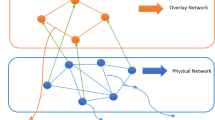Abstract
Small-world phenomena have been observed in existing peer-to-peer (P2P) networks which has proved useful in the design of P2P file-sharing systems. Most studies of constructing small world behaviours on P2P are based on the concept of clustering peer nodes into groups, communities or clusters. However, managing additional multilayer topology increases maintenance overhead, especially in highly dynamic environments. In this paper, we present Social-like P2P systems (Social-P2Ps) for object discovery by self-managing P2P topology with human tactics in social networks. In Social-P2Ps, queries are routed intelligently even with limited cached knowledge and node connections. Unlike community-based P2P file-sharing systems, we do not intend to create and maintain peer groups or communities consciously. In contrast, each node connects to other peer nodes with the same interests spontaneously by the result of daily searches.
Similar content being viewed by others
References
Liu L, Antonopoulos N, Mackin S (2007) Social peer-to-peer for resource discovery. In: 15th Euromicro international conference on parallel, distributed and network-based processing, Naples, Italy, February 2007. IEEE Computer Society Press, pp 459–466
Stoica I, Morris R, Karger D, Kaashoek MF, Balakrishnan H (2001) Chord: a scalable peer-to-peer lookup service for internet applications. In: ACM SIGCOMM, San Diego, CA, August 2001, pp 149–160
Ratnasamy S, Francis P, Handley M, Karp R, Shenker S (2001) A scalable content-addressable network. In: ACM SIGCOMM, San Diego, CA, August 2001, pp 161–172
Rowstron A, Druschel P (2001) Pastry: scalable, distributed object location and routing for large-scale peer-to-peer systems. In: IFIP/ACM international conference on distributed systems platforms, Heidelberg, Germany, November 2001
Antonopoulos N, Salter J (2004) Efficient resource discovery in grids and P2P networks. J Internet Res 14:339–346
Rhea S, Gells D, Roscoe T, Kubiatowicz J (2004) Handling churn in a DHT. In: The USENIX annual technical conference, Boston, MA, June 2004
Yang B, Garcia-Molina H (2004) Efficient search in peer-to-peer networks. In: International conference on distributed computing systems, Vienna, Austria, July 2002
Maymounkov P, Mazieres D (2002) Kademlia: a peer-to-peer information system based on the XOR metric. In: IPTPS, Cambridge, MA, March 2002
Milgram S (1967) The small world problem. Psychol Today 2:60–67
Hong T (2001) Chapter fourteen: performance. Peer-to-peer: harnessing the power of disruptive technologies. O’Reilly, pp 3–241
Watts D, Strogatz S (1998) Collective dynamics of small-world networks. Nature 393:440–442
Salter J, Antonopoulos N (2007) An optimised 2-Tier P2P architecture for contextualised keyword searches. Elsevier Futur Gener Comput Syst 23:241–251
Kleinberg J (2001) Small-world phenomena and the dynamics of information. Adv Neural Inf Process Syst (NIPS) 14:431–438
Liu L, Antonopoulos N, Mackin S (2007) Fault-tolerant peer-to-peer search on small-world networks. Futur Gener Comput Syst 23:921–931
Zhang H, Goel A, Govindan (2004) Using the small-world model to improve Freenet performance. Comput Netw 46:555–574
Cuenca-Acuna FM, Nguyen TD (2002) Text-based content search and retrieval in ad hoc P2P communities. In: International workshop on peer-to-peer computing, Pisa, Italy, May 2002
Khambatti MS, Ryu KD, Dasgupta P (2002) Efficient discovery of implicitly formed peer-to-peer communities. Int J Parallel Distributed Syst Netw 5:155–164
Vassileva J (2002) Motivating participation in peer-to-peer communities. In: Workshop on engineering societies in the agent world, Madrid, Spain, March 2002
Karp R, Shenker S, Schindelhauer C, Vocking B (2002) Randomized rumour spreading. In: 41st symposium foundation on computer science, Warsaw, Poland, August 2002
Bloom B (1970) Space/time tradeoffs in hash coding with allowable errors. Commun ACM 13:422–426
Crespo A, Garcia-Molina H (2002) Routing indices for peer-to-peer systems. In: International conference on distributed computing systems, Vienna, Austria, July 2002
JXTA. Available: http://www.jxta.org
Bearshare. Available: http://www.bearshare.com
Xiao L, Liu Y, Ni LM (2005) Improving unstructured peer-to-peer systems by adaptive connection establishment. IEEE Trans Comput 54:176–184
Chawathe Y, Ratnasamy S, Breslau L, Lanham N, Shenker S (2003) Making Gnutella-like P2P systems scalable. In: ACM SIGCOMM, Karlsruhe, Germany, August 2003
Tsoumakos D, Roussopoulos N (2003) Adaptive probabilistic search for peer-to-peer networks. In: International conference on peer-to-peer computing, Linkoping, Sweden, September 2003
Joseph S (2002) NeuroGrid: semantically routing queries in peer-to-peer networks. In: International workshop on peer-to-peer computing, Pisa, Italy, May 2002
Joseph S (2003) P2P MetaData search layers. In: International workshop on agents and peer-to-peer computing, Melbourne, Australia, July 2003
Borch N (2005) Social P2P for social people. In: International conference on Internet technologies & applications, Wrexham, UK, September 2005
Pouwelse J, Garbacki P, Wang J, Bakker A, Yang J, Iosup A, Epema D, Reinders M, Steen Mv, Sips H (2007) Tribler: a social-based peer-to-peer system. Concurr Comput Pract Experience 19:1–11
The Open Directory Project. Available: http://dmoz.org/
Kautz H, Selman B, Shah M (1997) Combining social networks and collaborative filtering. Commun ACM 40:63–65
Makosiej P, Sakaryan G, Unger H (2004) Measurement study of shared content and user request structure in peer-to-peer Gnutella network. In: International conference on design, analysis, and simulation of distributed computing system, Arlington, Virginia, April 2004
Pauli C, Shepperd M (2005) An empirical investigation into P2P file-sharing user behaviour. In: Americas conference on information systems, Omaha, Nebraska, August 2005
Saroiu S (2002) A measurement study of peer-to-peer file sharing systems. In: International conference on multimedia networking and computing, Santa Barbara, CA, October 2002
Krishna P (2003) Measurement, modelling and analysis of a P2P file-sharing workload. In: ACM symposium on operating systems principles, Bolton Landing, New York, October 2003
Ren Y et al (2003) Explore the “small world phenomena” in pure P2P information sharing system. In: International symposium on cluster computing and the grid, Tokyo, Japan, May 2003
Bhagwan R, Savage S, Voelker GM (2003) Understanding availability. In: International workshop on peer-to-peer system, Berkeley, CA, February 2003
Zhou H (2002) Scaling exponents and clustering coefficients of a growing random network. Phys Rev 66:016125
Author information
Authors and Affiliations
Corresponding author
Rights and permissions
About this article
Cite this article
Liu, L., Antonopoulos, N. & Mackin, S. Managing peer-to-peer networks with human tactics in social interactions. J Supercomput 44, 217–236 (2008). https://doi.org/10.1007/s11227-007-0156-y
Received:
Accepted:
Published:
Issue Date:
DOI: https://doi.org/10.1007/s11227-007-0156-y




